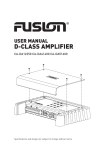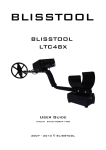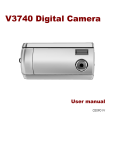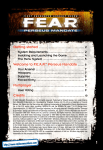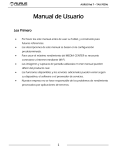Download Blisstool LTC48 User guide
Transcript
BLISSTOOL BLISSTOOL LTC48 User Guide version EN200908131904 2007 - 2009 © BLISSTOOL CONTENTS 1. Introduction.......................................................................................3 2. Features..............................................................................................3 3. Technologies ......................................................................................4 4. standard pack.....................................................................................4 5. Accessories.........................................................................................4 6. Device construction...........................................................................4 7. Device assembling and disassembling...............................................7 8. Control, adjustment and indication appliances.............................8 9. Device adjustment and preparation for work...............................11 10. Search method...............................................................................12 11. Battery charging...........................................................................13 12. Practical recommendations..........................................................14 13. Technical maintenance and service support during warranty..15 14. Legislation......................................................................................15 15. Contact information......................................................................15 BLISSTOOL LTC48 – User Guide (version EN200908131904) Page 2 of 15 1. Introduction BLISSTOOL LTC48 is a contemporary professional metal detector, designed to be used on any type of terrains. It features perfect depth and discrimination and is outstanding for its high quality, easy user’s adjustment and minimal maintenance need. That makes it appropriate for both the experienced seekers and the beginners in the field. It is equipped with a recharging 12V/2500mAh NiMH battery, ensuring up to 48 hours continuous work with a single charge. It mobility is complemented by light and robust detachable carrier construction made of duraluminum and carbon, light and robust ABS boxes, and 28cm (11") DD waterproof search coil. BLISSTOOL LTC48 features an adjustable audio threshold, an adjustable discriminator and two working modes for eliminating the ground interference: - Manual Ground Balance, appropriate for terrains with a homogeneous soil. In this working mode, the metal detector could reach its full potential by a fine manual adjustment, made by the user; - Automatic Ground Balance, appropriate for terrains with heterogeneous soil. In this working mode, a special part of the metal detector’s electronics automatically eliminates the ground interference. 2. Features – Technology: Induction balance – Working frequency: 8.5KHz – Working mode: motion – Sound discrimination of the metals – Manual and Automatic ground balance mode – Resistance in areas with heavy mineralized ground – 28cm (11") DD search coil BLISSTOOL DD28SC1 – Adjustable iron and tin-foil rejection level – Adjustable depth of discrimination – High recovery speed – Adjustable audio threshold – Adjustable audio volume control – 3.5mm Stereo headphones outlet – 12V/2500mAh NiMH built-in recharging battery – Single charge operating time: up to 48 working hours – Low battery indicator – Consumption: min:35mA, max:100mA – Automatic battery charger BLISSTOOL DA12250 – Light and robust ABS boxes – Detachable and adjustable carrier construction – Robust and comfortable handle and armrest – Weight in assembled mode (ready for work): 2kg – Developed and manufactured in Bulgaria – 3 Year Worldwide Warranty BLISSTOOL LTC48 – User Guide (version EN200908131904) Page 3 of 15 3. Technologies – adjustable audio threshold for fine adjustment of the device’s sensitivity; – adjustable discriminator, used to determine the detection/rejection level of ferrous metals (iron objects, heavily corroded iron) and tin-foil; – manual and automatic ground balance, used to eliminate the ground interference, coming from the soil alloys and pollutants; – high recovery speed enabling you to find deeper targets near iron; – automatic compensator, used to eliminate the influence of the environmental temperature alterations. 4. standard pack 1. Metal detector BLISSTOOL LTC48 with 28cm (11") DD search coil BLISSTOOL DD28SC1 and 12V/2500mAh built-in recharging battery BLISSTOOL GP122500 2. Automatic battery charger BLISSTOOL DA12250 3. User guide 4. Transport and storage box 5. 3 Year Worldwide Warranty 5. Accessories 1. Transport and storage rucksack 2. Stereo headphones 6. Device construction BLISSTOOL LTC48 consists of the following basic elements: 1. Carrier rod 2. Large fixing ring 3. Electronic control module with control and indication appliances 4. Handle 5. Armrest 6. Power supply module 7. Intermediate connecting rod 8. Small fixing ring 9. Lower connecting rod 10. Plastic bolt and nut 11. Search coil BLISSTOOL LTC48 – User Guide (version EN200908131904) Page 4 of 15 Fig.1 / Metal detector BLISSTOOL LTC48 – construction For easy assembling and disassembling of the device, in the standard pack: – the carrier rod, the fixing ring, the electronic control module, the handle, the armrest and the power supply module are combined in a single component; – the small fixing ring is mounted on the intermediate connecting rod; – the lower connecting rod and the search coil are assembled together with the plastic bolt and nut. Fig.2 / Metal detector BLISSTOOL LTC48 – components The search coil could be repeatedly mounted and dismounted from the lower connecting rod via the plastic bolt and nut. It is highly recommended that they should not be tightly fastened, to ensure that first - the thread could not be damaged and second - the search coil position could be easily changed during the search or when folded for carrying and transporting. The carrier rod is made from duraluminum pipe. The large fixing ring that is mounted on its lower end is used for connecting the pipe with the intermediate connecting rod. The electronic control module consists of a plastic box with room for the metal detector’s electronics. The control and indication appliances lie on the front and the back panel of the box. The handle is part of the carrier rod and is coated with soft and solid foam. For better stability, the armrest is made from duraluminum. The power supply module consists of a plastic box with room for the recharging 12V/2500mAh battery. A connector lies on the front panel of the box and is used for plugging in the battery charger jack (the battery charger is included in the standard pack), so that the charging of the battery could be carried out when needed. BLISSTOOL LTC48 – User Guide (version EN200908131904) Page 5 of 15 The intermediate connecting rod is made from duraluminum. At its upper end it is connected by the large fixing ring to the carrier rod – it fits into it, while at its lower end it is connected to the lower connecting rod. The lower connecting rod is made from carbon, so that it does not interfere with the normal working mode of the metal detector. At its upper end it is connected by the small fixing ring to the intermediate connecting rod – it fits into it, while at its lower part ends with a plastic nozzle by which is connected to the search coil. To not affect the intermediate connecting rod on the work of the metal detector because it is made from duraluminum, ie metal, it is recommended that the lower connecting rod to be inserted in the intermediate connecting rod to a situation in which remain at least 20-30 centimeters away from the top of the search coil to the small fixing ring. The search coil is connected to the plastic nozzle of lower connecting rod via the plastic bolt and nut. Between the "ears" of the search coil and the plastic nozzle of the lower connecting rod put emollient and fixed rubber type “washer”, which prevent "ears" of the search coil from deformation and breakage when tightening. The search coil has a connecting screened cable ending in a jack that is plugged in the connector that lies on the back panel of the electronic control module. If necessary to change the position of the search coil to the lower connecting rod (change the working angle) is necessary to loose coupling fixing by a plastic bolt and nut and after the new setting, it can be tight to be fix the search coil in the new position. Changing the working angle in tight situation can lead to breakage of the "ears" of the search coil, deformation of the "ears" and the search coil or a fatal frustration of the search coil and changes its parameters. When changing the working angle of the search coil to the lower connecting rod must be monitored for the presence of an advance of the bottom of the connecting cable connected to the search coil to keep it stretched too much as this can cause damage his. Recommended always to provide a small advance of the connecting cable of the search coil in his lower part, immediately which he comes out of the search coil. BLISSTOOL LTC48 – User Guide (version EN200908131904) Page 6 of 15 7. Device assembling and disassembling The metal detector BLISSTOOL LTC48 is assembled in the following sequence: 1. The upper part of the lower connecting rod is attached to the lower part of intermediate connecting rod via the small fixing ring, and adjusted at the appropriate length. It is recommended that the mounting of the lower connecting rod to the intermediate connecting rod should be carried out, following the sequence below: – the small fixing ring has to be unscrewed loose from the intermediate connecting rod and put on the lower connecting rod; – the lower connecting rod is inserted in the intermediate connecting rod at the appropriate length; – the small fixing ring is tightened until it is fixed. 2. The upper part of the intermediate connecting rod is attached to the carrier rod via the large fixing ring, and adjusted at the appropriate height. It is recommended that the mounting of the intermediate connecting rod to the carrier rod should be carried out, following the sequence below: – the large fixing ring has to be unscrewed loose from the carrier rod and put on the intermediate connecting rod; – the intermediate connecting rod is inserted in the carrier rod at the appropriate length; – the large fixing ring is tightened until it is fixed. 3. The search coil has to be adjusted horizontally against the ground surface, while the user is in an upright (working) position and is holding the metal detector by the handle. This adjustment is possible, if the plastic bolt and nut used for assembling the search coil with the lower connecting rod are not tightly fastened. 4. The connecting screened cable of the search coil is winded uniformly up the lower and intermediate connecting rods and the end jack of the cable is plugged in and tightened on the connector that lies on the back panel of the electronic control module. The cable, at its lower end near the search coil, has to be slightly loose, so that it is not damaged when the search coil has been bent against the lower connecting rod, for example when the device is folded for carrying and transporting. Additional, the cable can be fixed through patches included in the standard pack. The coil cable ends with a jack and there is a single correct position for it so that it could be plugged in the coil connector, which lies on the back panel of the electronic control module. In this position, the “hollow” cursor of the jack falls in with “flange” cursor of the connector, and when inserted, the jack enters the connector into a depth of around 10 mm. After the jack is plugged in, it is screwed to the connector by the means of the available metal stopping nut, used as a shield. The incorrect insertion and/or the application of a brute force while incorrectly inserting the jack could lead to damaging the metal detector. The plugging in and out of the jack is done while the metal detector is switched off (VOLUME/POWER knob is turned in “OFF” position (Fig.3)). The disassembling of the device is carried in a reversed order. BLISSTOOL LTC48 – User Guide (version EN200908131904) Page 7 of 15 8. Control, adjustment and indication appliances The control, adjustment and indication appliances lie on the front (Fig.3) and the back panel of the electronic control module. Description of the particular appliances: 1. VOLUME/POWER knob: - It serves for both switching on/switching off the metal detector and adjusting the audio volume control. The chosen position from the knob scale (usually between the 3rd and the 5th level) should correspond to pleasant sounds made by the metal detector, i.e. that are neither loud, nor quiet. 2. GROUND switch: - It serves for switching between the two working modes of the metal detector: MANUAL: Manual ground balance AUTO: Automatic ground balance Those two working modes relate to the chosen technology for eliminating the ground (terrain) interference on the metal detector’s work. This interference usually causes instability of the device and false signal registration (during the course of the search while the search coil is moving, the device is making sounds without necessarily detecting a real iron object). When in a manual ground balance working mode (GROUND switch turned to the MANUAL position), the ground interference is eliminated by manual adjustment of the metal detector by the user, by following the procedure given in the description of the GROUND knob below. This working mode is appropriate for terrains with homogeneous soil, where the metal detector would reach its full potential by a fine manual adjustment. When in an automatic ground balance working mode (GROUND switch turned to the AUTO position), the metal detector’s electronics automatically eliminates the ground interference and there is no further need for manual balance adjusting by the user and no further relation with the chosen GROUND knob level. This working mode is appropriate for terrains with a heterogeneous soil. 3. GROUND knob: - It serves for suppressing the ground interference while in a manual ground balance working mode. The steps for the manual adjustment of the ground balance are: - choose the manual ground balance working mode (GROUND switch turned to MANUAL position); - turn the DISCR knob to GBS position (Ground Balance Setting); - turn THRESHOLD knob to a level, that corresponds to a quiet “buzzing” sound made by the metal detector (makes recurring sounds). The manual balancing is made through vertical (up-down) movement of the search coil ranging from 2-3 cm to 20-25 cm above the terrain, simultaneously with turning the GROUND knob. At some levels of the GROUND knob scale, the sound is louder when the search coil is near the ground, while at others the sound is louder when the search coil is high above the ground. The balancing is actually finding the level (position) from the GROUND knob that corresponds to a stable sound, predefined from the THRESHOLD knob (quiet “buzzing”), and made by the metal detector while the search coil is moved according to the above described way. There might be some problems with the manual balancing via quiet “buzzing” on heavily mineralized terrains. In these cases, the THRESHOLD knob is turned one level backwards compared to the level at which the metal detector is making quiet “buzzing” sounds, i.e. the metal detector should not make any sounds while at rest. In that case, the balancing has to follow once again the above-described vertical movement of the search coil and the turning of the GROUND knob, besides that here the aim is to achieve “silent” metal detector. In similar situations, if the balancing is quite difficult, to assist in achieving a balance, one might adjust the desired level of discrimination in advance (the DISCR knob is switched from GBS position into the desired working mode) and then carry the BLISSTOOL LTC48 – User Guide (version EN200908131904) Page 8 of 15 balancing process of the device according to the above description. The balancing should be carried at an area with no metal objects near the search coil (otherwise they would interfere the balancing process). This is easily established, if the GROUND knob is turned to a middle position and the search coil is moved horizontally above the terrain, i.e. without changing its distance towards the ground. When there are no metal objects, the predefined from the THRESHOLD knob sound would not be changed. One other possibility is the chosen balancing area to be searched for iron objects in advance while using the automatic ground balance working mode (GROUND switch turned to AUTO position). After the balancing has been finished, the GROUND switch remains in MANUAL position (manual ground balance), while the DISCR and THRESHOLD knobs are turned to the desired levels. When changing the terrain (changing the soil characteristics) the device should be balanced again following the above-described way, so that it remains stable. 4. THRESHOLD knob: - It serves for assigning the necessary audio threshold. It is adjusted with no metal objects around the metal detector’s search coil and depends on the terrain. The best depth for finding metal objects is achieved, when the THRESHOLD knob is turned in a position, corresponding to a quiet “buzzing” sound made by the metal detector in working mode (makes recurring sound). This mode is suitable for experienced seekers. The beginners should work at lower levels. When in manual ground balance working mode, the device should be balanced before the final audio threshold level is assigned. The maximal audio threshold corresponding to a stable device condition depends on the terrain’s characteristics, the device balancing (in the manual ground balance working mode) and the search speed. 5. DISCR knob: - It serves for adjusting the iron and tin-foil detection/rejection level and for adjusting the depth of discrimination (the maximum depth to which the metal detector distinguish the metals). In “0” position, the metal detector makes unaltered sound for all metals, i.e. it does not distinguish them. That is why this position is the same as the “GBS” position, which is used for balancing of the device, with the aim of achieving the maximal balance for a particular terrain. When the level is turned to a higher position, the metal detector starts to distinguish the metals, and each successive level betters the discrimination, i.e. at level “10”, the metal detector rejects the iron and the tin-foil at an utmost degree and has the maximum depth of discrimination. When detecting non-ferrous metals (copper, bronze, silver, gold) it makes deep-toned, non-pausing sound, while for the ferrous metals (iron) the sound is pausing (recurring). For levels from “5” to “10”, the metal detector rejects the iron and tin-foil objects at a different level, i.e. when detecting iron or tin-foil object it is making either no sound or a quiet pop sound. The most practical working mode, when searching for non-ferrous metals, are the levels from “6” to “8”. When detecting unstable (whether its corresponding to a real object) signal - usually for heavily corroded iron or iron with alloys, the level could be turned to “10” in order to get more accurate signal discrimination. The surface sweeping of the particular terrain could contribute to the further improvement of the detecting, because it results in shortening the distance to the buried detected object. In many polluted areas, small corrosion iron pieces such as wire, small sheet iron, etc., fall in the area of regulating the ground balance, not discrimination. To this end, they are ignored in manual ground balance mode and the metal detector is balanced directly on them (corrosion piece of wire or sheet iron) to completely ignore them (usually between level 8 and level 10 of potentiometer GROUND + potentiometer DISCR between level 8 and level 10). BLISSTOOL LTC48 – User Guide (version EN200908131904) Page 9 of 15 6. Loudspeaker: - It serves for producing a sound when an object is detected. The sound is deep-toned and non-pausing for non-ferrous metals and recurring (repeating) for ferrous metals (iron). The loudspeaker lies on the back panel of the electronic control module. 7. PHONES jack: - If necessary, the stereo headphones with 3.5mm jack could be plugged in the PHONES jack. When the headphones are plugged in, the loudspeaker is switched off automatically and the metal detector’s sound could be heard only in the headphones. 8. BAT LOW light indicator: - It indicates the current charge of the battery. The indicator lits up when the battery is exhausted. It is recommended that the metal detector should not be used in this mode, as it would not work properly. The charging of the battery should be carried according to the description in 11. Fig.3 / Control, adjustment and indication appliances of BLISSTOOL LTC48 BLISSTOOL LTC48 – User Guide (version EN200908131904) Page 10 of 15 9. Device adjustment and preparation for work The metal detector is ready for use when the battery is charged (the BAT LOW indicator is not lit up). Before the initial usage, please charge the battery for minimum of 8 hours, by using the automatic battery charger available in the standard pack, according to the description in 11. The built-in battery ensures up to 48 working hours without recharging. After the metal detector is assembled according to the description in 7, it can be turned on via turning the VOLUME/POWER knob from left (position OFF) to right. This knob also serves for adjusting the desired audio volume control. The GROUND switch is used for switching between the manual and the automatic mode for eliminating the ground interference, according to the description in 8.2. When choosing the manual ground balance, the device should be balanced according to the description in 8.3. The discrimination level and depth of discrimination (for distinguishing the metals) is adjusted with the DISCR knob according to the description in 8.5. DISCR has to be turned to “0” level, if aiming at detection of all metals. DISCR has to be turned from “6” to “10” level, when aiming at ignoring the ferrous metals (detecting only nonferrous metals). The higher the level, the better ignoring of the heavily corroded iron is achieved, and the metals are discriminated at a greater depth (depth of discrimination). And lastly, the THRESHOLD knob adjusts the audio threshold to the desired level. With this, the metal detector is adjusted and ready for work. BLISSTOOL LTC48 – User Guide (version EN200908131904) Page 11 of 15 10. Search method The metal detector searches while being moved, i.e. it reacts to a metal object buried in the ground only when the search coil is swung above it. Searching for metal objects is actually moving the search coil above the ground surface. While doing this, the search coil has to be held parallel towards the ground surface and at a minimum distance above it. The more lifted the coil, the less deeply the search. The search consists of a uniform and slow swinging of the coil one side to another, while the user holds the metal detector’s handle and uses the armrest for support. Too fast or too slow moving of the coil could result in shortening the search depth, especially for deeply buried or small objects. The search coil path during the search resembles a zigzag movement, which is a result from the uniform and slow swinging of the coil one side to another while the user is moving forward. The swing’s breadth and the user’s speed are chosen according to the terrain, the sloping and the size of the area to be searched. During swinging the user should avoid hitting the search coil in the available objects on the terrain (stones, tree roots and tree parts, uneven ground, etc.) The precise location of the detected object is determined by moving the search coil in two perpendicular axes, while the user stands still or turns round for detecting the signal from different sides. BLISSTOOL LTC48 – User Guide (version EN200908131904) Page 12 of 15 11. Battery charging The metal detector BLISSTOOL LTC48 has 12V/2500mAh NiMH battery that is placed inside the power supply module. The battery has around 500 charging/discharging cycles (battery “life”), after which its capacitance drops sharply and must be replaced with a new battery. The battery charging has to be done only by the automatic battery charger BLISSTOOL DA12250 (~220/12V, 250mA) that is included in the standard pack. The specified battery charger is designed to ensure the quality and safety during the battery charging process. To charge the battery, plug in the battery charger jack into the connector that lies on the front panel of the power supply module. Then the battery charger contact-plug is plugged into the ~220V circuit. The charging continues from 3 to 12 hours, depending on the battery level of discharge. It is not required to keep a close watch on the charging process, as the charger is automatic and after the battery charging is finished it switches to a stand-by mode, which protects the battery from over-charging. The green light indicator lits up when the battery charger is plugged in ~220V circuit, which indicates that the charger is working properly. The charging process and the charging stages are indicated with the different light intensity of the red light indicator – when the battery is discharged, it is either out or is dimly lit up, while during the charging process the intensity is increased, resulting in a bright intensity when fully charged. After the charging process has been finished, the battery charger should be switched off following the reversed order: plugging off the ~220V circuit by pulling out the power supply contact-plug from the wall-plug, then the battery charger jack is plugged off. During charging, the metal detector should be switched off. Switching on the detector while being charged could cause serious damage to the electronic control module or to decrease the detector’s search quality. The built-in battery does not need any further maintenance besides being charged. BLISSTOOL LTC48 – User Guide (version EN200908131904) Page 13 of 15 12. Practical recommendations One of the most important components of the metal detector is the search coil, which to a great extend determines the device’s sensitivity. When the metal detector is carried, for example in a rucksack or a travelling bag, an exceptional care should be taken to avoid the bending of the coil cable near the muff at the base of the search coil. That may result in tearing the cable connecting cores and damaging of the search coil and the metal detector. When necessary, the search coil, the electronic control module box and the power supply module box could be cleaned with wet cloth. Do not use detergents as they may damage the plastic parts or the inscription on the front panel of the electronic control module. The electronic control module and the search coil are very sensitive towards sudden environmental temperature alterations. When there is a sudden temperature change, the user should wait usually 25-30 minutes before switching on the metal detector. While working with the metal detector, the search coil should be protected from damage (hit). The usage of the metal detector in a rainy day may result in its damage. The metal detector could be safely and properly used, if there is morning dew (because of the watertight search coil). An extensive care should be taken, if the detector is put on the ground, especially on a wet grass, as the water should not be allowed to get inside the electronic control module box and the power supply module box. The electronic control module and the power supply module are not watertight and a serious damage would be caused to the metal detector, if water gets inside them. If you are searching in areas, where ammunitions or other explosive substances may be detected, be extremely careful when excavating, because we do not carry the responsibility for your actions and behavior. Do not open the electronic control module box and the power supply module box. If this is necessary, please contact us, using the contact information, given in 15, so that we could provide the appropriate technical support. BLISSTOOL LTC48 – User Guide (version EN200908131904) Page 14 of 15 13. Technical maintenance and service support during warranty The metal detector BLISSTOOL LTC48 has a 3 Year Worldwide Warranty for the quality of the produced components and in case of any factory flaws. The warranty excludes the battery and is not valid for mechanical damages of the respective components and for damages done by an incorrect usage or unauthorized access and repair (opening the electric control module; opening the power supply module; wearing, force opening or damaging of the carrier construction, the search coil, the cable or the jack for the coil; incorrect plugging of the search coil; damaging the detector due to connecting to incompatible search coils, batteries, battery chargers and headphones). To be a subject of a repair under warranty, a device should be delivered to any of our authorized service support offices. The customer must pay all delivery and transport expenses. In order to protect the metal detector from a damage, it is desirable that the transport of the device should be carried out in its original purchase box (included in the standard pack), since it is optimized for a safe storage and transport. The serial number and the purchase date, written on the warranty card, verify the warranty. For further details and information regarding the technical maintenance and service support both for devices with current or expired warranty, please contact us by using the contact information, given in 15. 14. Legislation The possession of a metal detector is completely legal, as long as you comply with the existing legislation. That is why we recommend you to avoid searching in a private property, national parks and archaeological reserves. 15. Contact information BLISSTOOL web site: www.blisstool.com Email: [email protected] GSM: +359883450667 Skype: blisstool ooVoo: blisstool 2007 - 2009 © BLISSTOOL ALL RIGHTS RESERVED BLISSTOOL LTC48 – User Guide (version EN200908131904) Page 15 of 15
















